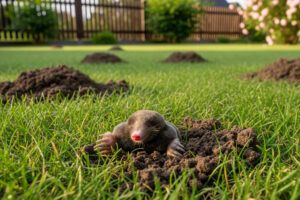 Moles can be a significant nuisance for homeowners and landscape enthusiasts alike. Their tunneling habits can wreak havoc on lawns, gardens, and flower beds, leading to unsightly molehills and potential damage to plant roots. Understanding how to effectively manage and remove moles is crucial for maintaining a healthy and beautiful landscape. This article will explore various methods for mole control, the benefits and drawbacks of having moles in your yard, and tips for preventing future infestations.
Moles can be a significant nuisance for homeowners and landscape enthusiasts alike. Their tunneling habits can wreak havoc on lawns, gardens, and flower beds, leading to unsightly molehills and potential damage to plant roots. Understanding how to effectively manage and remove moles is crucial for maintaining a healthy and beautiful landscape. This article will explore various methods for mole control, the benefits and drawbacks of having moles in your yard, and tips for preventing future infestations.
Understanding Moles: The Basics
Moles are small, burrowing mammals that belong to the family Talpidae. They are primarily insectivores, feeding on a diet that includes earthworms, grubs, and other soil-dwelling insects. Moles are often mistaken for rodents, but they are more closely related to shrews. Their bodies are adapted for digging, featuring powerful front limbs and a cylindrical shape that allows them to navigate through the soil with ease.
Physical Characteristics
-
- Size: Moles typically range from 4 to 8 inches in length, with a velvety coat that can vary in color from gray to brown.
- Adaptations: Their paddle-like feet and sharp claws are designed for efficient digging, allowing them to create extensive tunnel systems beneath the surface.
- Vision: Moles have very small eyes and are nearly blind, relying on their sense of touch and smell to navigate their underground environment.
Habitat and Behavior
Moles prefer moist, loose soil that is rich in insects. They create two types of tunnels: deep runways, which are used for travel and food storage, and surface tunnels, which are primarily for foraging. The presence of raised ridges and molehills in your yard is a clear indication of their activity.
Signs of a Mole Infestation
Identifying a mole problem early can help mitigate damage to your landscape. Here are some common signs to look for:
- Molehills: These are cone-shaped mounds of soil that appear when moles push dirt to the surface while digging.
- Raised Ridges: Surface tunnels create visible ridges in the lawn, indicating active foraging behavior.
- Damaged Plants: Uprooted or wilting plants may signal that moles are disrupting their root systems.
The Impact of Moles on Your Landscape
While moles can be beneficial by aerating the soil and controlling insect populations, their tunneling can lead to several issues:
Lawn Damage
Moles can create uneven surfaces in your yard, making it difficult to mow and potentially causing injuries to people and pets. The raised tunnels can also lead to patches of dead grass as the roots are disturbed.
Garden and Flower Bed Disruption
Moles can uproot delicate plants and flowers, leading to costly replacements and extensive repairs. Their tunneling can also create an unsightly appearance in well-maintained gardens.
Soil Erosion
The extensive tunneling systems created by moles can lead to soil erosion, particularly in areas with loose or sandy soil. This can further exacerbate lawn damage and negatively impact plant health.
Effective Mole Removal Techniques
When it comes to managing a mole problem, several methods can be employed. Here are some of the most effective strategies for mole removal:
Trapping
Trapping is widely regarded as the most effective method for controlling mole populations. There are various types of traps available, including:
-
- Harpoon Traps: These traps are designed to kill moles quickly and are placed in active tunnels.
- Pitfall Traps: These traps capture moles alive, allowing for relocation.
How to Set a Trap
-
- Identify Active Tunnels: Look for freshly disturbed soil and raised ridges.
- Prepare the Trap: Follow the manufacturer’s instructions to set the trap correctly.
- Place the Trap: Position the trap in the active tunnel, ensuring it is flush with the ground.
- Check Regularly: Monitor the trap daily to see if it has captured a mole.
Repellents
While trapping is often the most effective method, some homeowners may prefer to use repellents. Natural repellents, such as castor oil, can deter moles from entering specific areas of your yard.
Application Tips
-
- Mix castor oil with water and a few drops of dish soap.
- Spray the mixture on areas where moles are active.
- Reapply after heavy rain to maintain effectiveness.
Chemical Control
Chemical solutions, such as insecticides, can be used to reduce the food supply for moles. However, this method should be approached with caution, as it can also harm beneficial insects and disrupt the ecosystem.
Professional Services
If the mole problem persists or is particularly severe, hiring a professional pest control service may be the best option. These experts can assess the situation and implement effective removal strategies tailored to your specific needs.
Preventing Future Mole Infestations
Once you have successfully removed moles from your landscape, taking steps to prevent their return is essential. Here are some effective prevention strategies:
Maintain a Healthy Lawn
A well-maintained lawn is less attractive to moles. Regular mowing, watering, and fertilization can help keep your yard healthy and less inviting to these pests.
Control Insect Populations
Since moles primarily feed on insects, reducing their food sources can help deter moles from returning. Consider using beneficial nematodes or other natural pest control methods to manage insect populations.
Install Barriers
Creating physical barriers, such as underground fencing, can help prevent moles from entering your yard. Burying wire mesh or hardware cloth at least 12 inches deep around the perimeter of your property can be effective.
The Pros and Cons of Moles in Your Yard
While moles are often viewed as pests, they can also provide some benefits to your landscape. Understanding the pros and cons can help you make an informed decision about how to manage them.
Benefits of Moles
-
- Soil Aeration: Moles help aerate the soil, improving drainage and promoting healthy root growth.
- Pest Control: By feeding on insects, moles can help keep pest populations in check.
Drawbacks of Moles
-
- Landscape Damage: Their tunneling can lead to unsightly molehills and damage to plants.
- Injury Risk: Uneven surfaces created by moles can pose a tripping hazard for people and pets.
Frequently Asked Questions About Mole Control
How can I tell if I have moles in my yard?
Look for signs such as molehills, raised ridges, and damaged plants. If you notice these indicators, it’s likely that moles are present.
What is the best time to trap moles?
Moles are most active in the early morning and late evening, particularly during spring and fall. Setting traps during these times can increase your chances of success.
Are there any home remedies for mole control?
Natural repellents, such as castor oil, can be effective in deterring moles. However, trapping remains the most reliable method for removal.
Can moles cause structural damage to my home?
While moles primarily affect lawns and gardens, their tunneling can lead to soil erosion, which may indirectly impact the foundation of your home if left unchecked.
Managing moles in your landscape requires a combination of effective removal techniques and preventive measures. By understanding the behavior of moles and implementing the strategies outlined in this article, you can maintain a healthy and beautiful yard free from the disruption caused by these burrowing mammals. Whether you choose to tackle the problem yourself or enlist the help of professionals, taking action promptly will help protect your landscape investment and ensure its long-term health.
We Provide Mole Control Services
We place a worm-shaped mole bait for moles who are currently creating tunnels. After just one feeding, that particular mole will no longer be a problem in about 2 days. Stay clear of these mole tunnels (runs) until you don’t see any more mole activity.
> Learn More
Contact Us (859-384-0266) for a Free Consultation!
Get an Instant Quote
—
 About A & A Lawn Care & Landscaping
About A & A Lawn Care & Landscaping
A & A Lawn Care & Landscaping can beautify your lawn and landscaping using our vast experience in turf grass management. Our complete lawn service is designed for both residential and commercial lawns and we keep your lawn healthy without harming your family, staff, or pets.